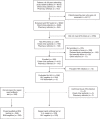Acute HIV-1 infection is as common as malaria in young febrile adults seeking care in coastal Kenya
- PMID: 24556872
- PMCID: PMC4032215
- DOI: 10.1097/QAD.0000000000000245
Acute HIV-1 infection is as common as malaria in young febrile adults seeking care in coastal Kenya
Abstract
Background: Febrile adults are usually not tested for acute HIV-1 infection (AHI) in Africa. We assessed a strategy to diagnose AHI among young adult patients seeking care.
Methods: Young adults (<30 years) who met predefined AHI criteria at care seeking, including fever, sexually transmitted disease symptoms, diarrhoea, body pains or multiple partners were referred from five pharmacies and screened at five health facilities. Prevalent HIV-1 was diagnosed by nationally recommended serial rapid HIV-1 testing. Willing HIV-1-negative patients were evaluated for AHI, defined as a positive p24 antigen test, and subsequent seroconversion or RNA detection. Febrile patients evaluated for AHI were also screened for malaria using a rapid test, with PCR confirmation of positives.
Results: In 3602 adults seeking care, overall HIV-1 prevalence was 3.9%: 7.6% (68/897) among patients meeting AHI criteria vs. 2.6% (71/2705) among those who did not (P < 0.001). AHI was diagnosed in five of 506 HIV-1-negative or discordant patients who met AHI risk criteria and were completely evaluated [prevalence 1.0%, 95% confidence interval (CI) 0.3-2.3%]. Of these five AHI cases, four were diagnosed among the 241 patients with fever (prevalence 1.7%, 95% CI 0.5-4.2%), vs. one among 265 non-febrile patients (prevalence 0.4%, 95% CI 0.0-2.0%, P = 0.1). Malaria was confirmed by PCR in four (1.7%) of the 241 febrile patients.
Conclusion: AHI was as common as confirmed malaria in young febrile adults seeking care. An AHI detection strategy targeting young febrile adults seeking care at pharmacies and health facilities is feasible and should be considered as an HIV-prevention strategy in high-transmission settings.
Figures
References
-
- Tindall B, Barker S, Donovan B, Barnes T, Roberts J, Kronenberg C, et al. Characterization of the acute clinical illness associated with human immunodeficiency virus infection. Arch Intern Med 1988; 148:945–949 - PubMed
-
- Schacker T, Collier AC, Hughes J, Shea T, Corey L. Clinical and epidemiologic features of primary HIV infection. Ann Intern Med 1996; 125:257–264 - PubMed
-
- Sanders EJ, Wahome E, Mwangome M, Thiong’o AN, Okuku HS, Price MA, et al. Most adults seek urgent healthcare when acquiring HIV-1 and are frequently treated for malaria in coastal Kenya. AIDS 2011; 25:1219–1224 - PubMed
-
- Hollingsworth TD, Anderson RM, Fraser C. HIV-1 transmission, by stage of infection. J Infect Dis 2008; 198:687–693 - PubMed
-
- Cohen MS, Gay CL, Busch MP, Hecht FM. The detection of acute HIV infection. J Infect Dis 2010; 202 Suppl 2:S270–277 - PubMed
Publication types
MeSH terms
Grants and funding
LinkOut - more resources
Full Text Sources
Other Literature Sources
Medical
Molecular Biology Databases
Miscellaneous


